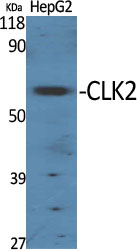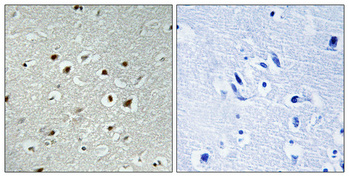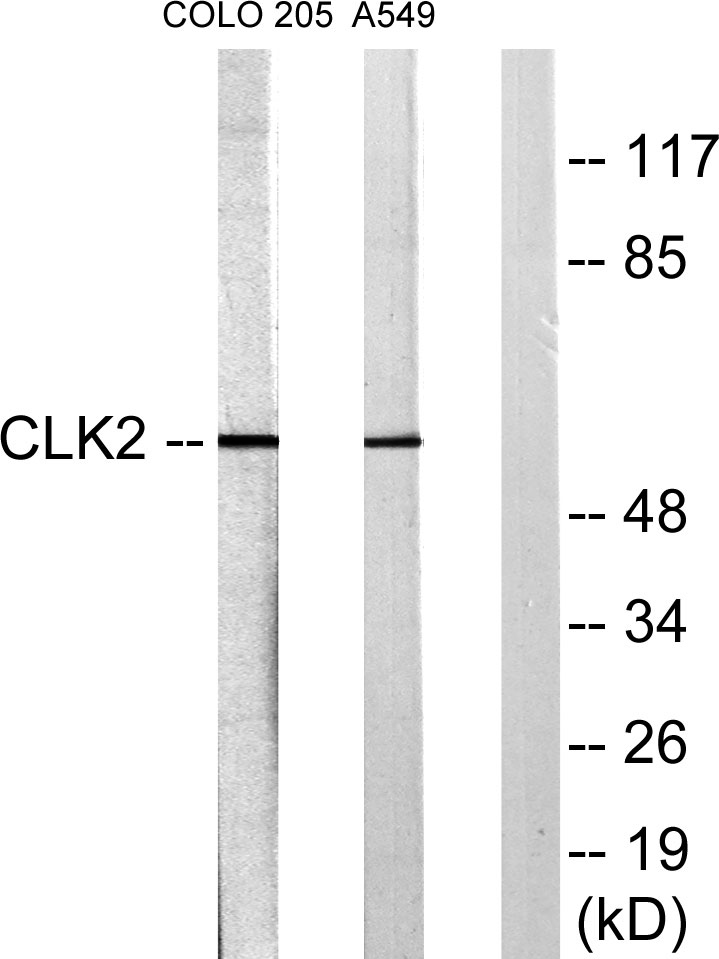CLK2 Polyclonal Antibody
- Catalog No.:YT0972
- Applications:WB;IHC;IF;ELISA
- Reactivity:Human;Mouse;Rat
- Target:
- CLK2
- Gene Name:
- CLK2
- Protein Name:
- Dual specificity protein kinase CLK2
- Human Gene Id:
- 1196
- Human Swiss Prot No:
- P49760
- Mouse Gene Id:
- 12748
- Mouse Swiss Prot No:
- O35491
- Immunogen:
- The antiserum was produced against synthesized peptide derived from human CLK2. AA range:1-50
- Specificity:
- CLK2 Polyclonal Antibody detects endogenous levels of CLK2 protein.
- Formulation:
- Liquid in PBS containing 50% glycerol, 0.5% BSA and 0.02% sodium azide.
- Source:
- Polyclonal, Rabbit,IgG
- Dilution:
- WB 1:500 - 1:2000. IHC 1:100 - 1:300. ELISA: 1:20000.. IF 1:50-200
- Purification:
- The antibody was affinity-purified from rabbit antiserum by affinity-chromatography using epitope-specific immunogen.
- Concentration:
- 1 mg/ml
- Storage Stability:
- -15°C to -25°C/1 year(Do not lower than -25°C)
- Other Name:
- CLK2;Dual specificity protein kinase CLK2;CDC-like kinase 2
- Observed Band(KD):
- 60kD
- Background:
- CDC like kinase 2(CLK2) Homo sapiens This gene encodes a dual specificity protein kinase that phosphorylates serine/threonine and tyrosine-containing substrates. Activity of this protein regulates serine- and arginine-rich (SR) proteins of the spliceosomal complex, thereby influencing alternative transcript splicing. Chromosomal translocations have been characterized between this locus and the PAFAH1B3 (platelet-activating factor acetylhydrolase 1b, catalytic subunit 3 (29kDa)) gene on chromosome 19, resulting in the production of a fusion protein. Note that this gene is distinct from the TELO2 gene (GeneID:9894), which shares the CLK2 alias, but encodes a protein that is involved in telomere length regulation. There is a pseudogene for this gene on chromosome 7. Alternative splicing results in multiple transcript variants. [provided by RefSeq, Jun 2014],
- Function:
- catalytic activity:ATP + a protein = ADP + a phosphoprotein.,function:Phosphorylates serine- and arginine-rich (SR) proteins of the spliceosomal complex may be a constituent of a network of regulatory mechanisms that enable SR proteins to control RNA splicing. Phosphorylates serines, threonines and tyrosines.,PTM:Autophosphorylates on all three types of residues.,similarity:Belongs to the protein kinase superfamily.,similarity:Belongs to the protein kinase superfamily. CMGC Ser/Thr protein kinase family. Lammer subfamily.,similarity:Contains 1 protein kinase domain.,
- Subcellular Location:
- Nucleus .; [Isoform 1]: Nucleus . Nucleus speckle . Inhibition of phosphorylation at Ser-142 results in accumulation in the nuclear speckle. .; [Isoform 2]: Nucleus speckle . Co-localizes with serine- and arginine-rich (SR) proteins in the nuclear speckles. .
- Expression:
- Endothelial cells (PubMed:19168442). Expressed in androgen-dependent prostate cancer cells (PubMed:28289210).
- June 19-2018
- WESTERN IMMUNOBLOTTING PROTOCOL
- June 19-2018
- IMMUNOHISTOCHEMISTRY-PARAFFIN PROTOCOL
- June 19-2018
- IMMUNOFLUORESCENCE PROTOCOL
- September 08-2020
- FLOW-CYTOMEYRT-PROTOCOL
- May 20-2022
- Cell-Based ELISA│解您多样本WB检测之困扰
- July 13-2018
- CELL-BASED-ELISA-PROTOCOL-FOR-ACETYL-PROTEIN
- July 13-2018
- CELL-BASED-ELISA-PROTOCOL-FOR-PHOSPHO-PROTEIN
- July 13-2018
- Antibody-FAQs
- Products Images

- Western Blot analysis of various cells using CLK2 Polyclonal Antibody cells nucleus extracted by Minute TM Cytoplasmic and Nuclear Fractionation kit (SC-003,Inventbiotech,MN,USA).
.jpg)
- Western Blot analysis of A549 cells using CLK2 Polyclonal Antibody cells nucleus extracted by Minute TM Cytoplasmic and Nuclear Fractionation kit (SC-003,Inventbiotech,MN,USA).

- Immunohistochemical analysis of paraffin-embedded Human brain. Antibody was diluted at 1:100(4° overnight). High-pressure and temperature Tris-EDTA,pH8.0 was used for antigen retrieval. Negetive contrl (right) obtaned from antibody was pre-absorbed by immunogen peptide.

- Western blot analysis of lysates from COLO205 and A549 cells, using CLK2 Antibody. The lane on the right is blocked with the synthesized peptide.



